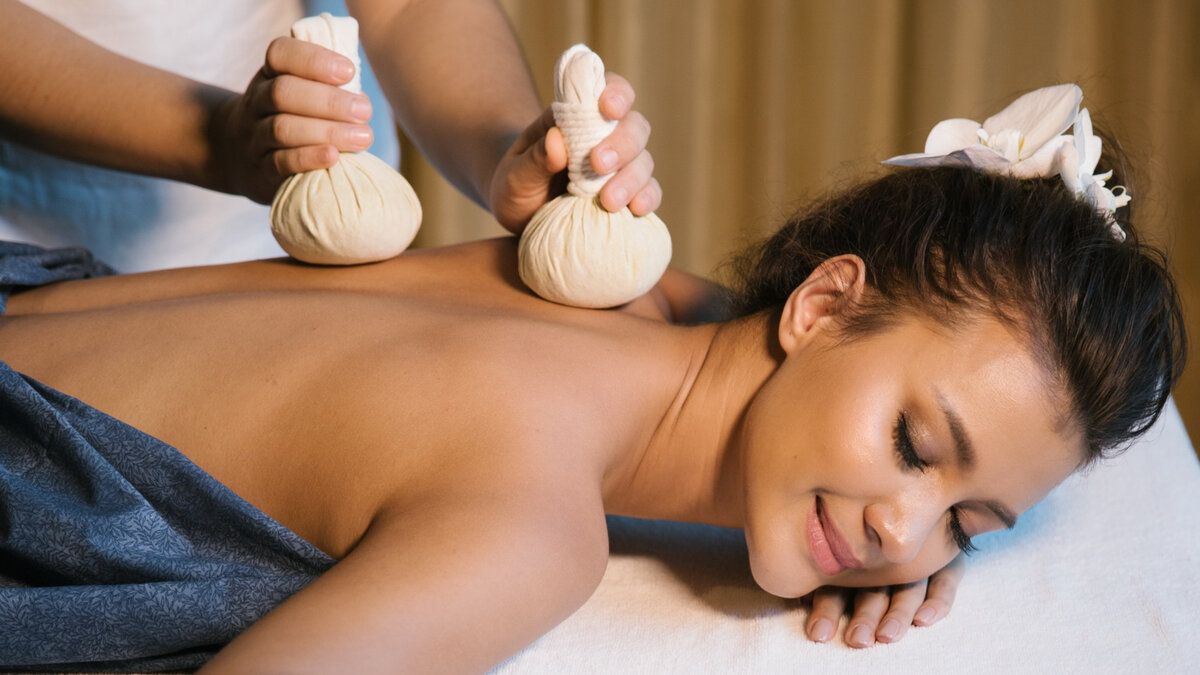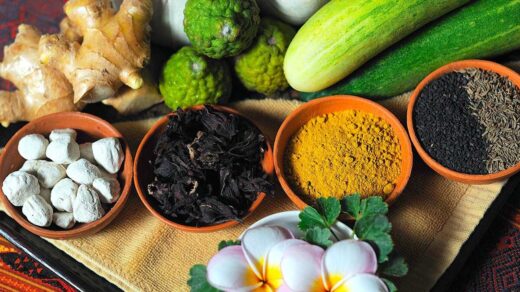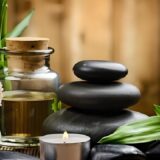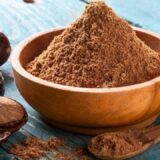Podikizhi: An Ancient Herbal Therapy for Rejuvenation and Healing
Podikizhi is a relaxing Ayurvedic therapy that utilizes a specific herbal powder containing 12 rejuvenating herbs. The herbal powder is enclosed in a pouch, known as a ‘kizhi,’ which is then warmed and used to massage various parts of the body. Before administering the treatment, the patient’s dosha predominance and disease are diagnosed to determine the appropriate ingredients and type of kizhi required for the therapy.
This revitalizing massage treatment typically lasts for about an hour. Podikizhi has proven to be effective in addressing joint diseases such as arthritis, various neurological conditions, and aiding in weight reduction. It is often recommended to undergo an abhyanga or oil body massage before receiving the Podikizhi treatment to enhance its benefits.
The Roots of Podikizhi
Ancient Origins
Podikizhi, an ancient therapeutic practice, has its origins deeply rooted in the traditional Indian system of medicine known as Ayurveda.
With a history spanning over 5,000 years, Ayurveda emphasizes a holistic approach to health and wellness, taking into consideration the interconnectedness of the mind, body, and spirit.
Within this ancient system, Podikizhi has stood the test of time as a trusted and effective healing modality.
Ayurvedic Principles
At the core of Ayurveda lie the principles of balance and harmony. According to this philosophy, every individual is composed of a unique combination of three fundamental energies, known as doshas – Vata, Pitta, and Kapha.
The balance between these doshas determines a person’s physical, mental, and emotional state. When there is an imbalance in these energies, it can lead to various health issues.
Ayurvedic therapies, including Podikizhi, aim to restore this equilibrium and promote overall well-being. The practice of Podikizhi is deeply intertwined with the principles of Ayurveda, making it a time-honored and highly personalized healing technique.
Understanding Podikizhi
Podikizhi Meaning: What is Podikizhi?
Podikizhi is a soothing Ayurvedic therapy that involves the use of a unique herbal powder comprising 12 rejuvenating herbs.
This herbal blend is carefully placed inside a cloth pouch, commonly referred to as a ‘kizhi.’ The pouch is then warmed to a suitable temperature and gently massaged or patted on different areas of the body.
The Concept of Doshas
In Ayurveda, it is believed that every individual possesses a unique combination of the three doshas. These doshas govern various physiological and psychological functions in the body.
When the doshas are in harmony, the body functions optimally. However, imbalances in the doshas can lead to health problems. Podikizhi, tailored to an individual’s dosha type, aims to restore balance and alleviate the root causes of ailments.
Powerful Herbal Blends
The efficacy of Podikizhi lies in the careful selection and preparation of the herbal blends used in the therapy. The herbal powders are derived from medicinal plants known for their therapeutic properties.
Common herbs used in Podikizhi blends include ginger, turmeric, neem, calamus, and a variety of other medicinal leaves. Each herb contributes to the overall healing effects of the treatment.
The Podikizhi Procedure
Preparation of Herbal Powders
The first step in the Podikizhi procedure involves the meticulous preparation of herbal powders. Highly skilled practitioners select the appropriate herbs based on the individual’s dosha type and health condition.
The herbs are then ground into fine powders to maximize their potency and effectiveness.
Cloth Bundles Filled with Herbs
Once the herbal powders are ready, they are carefully placed inside clean, natural cloth bundles. These bundles are then securely tied to form the therapeutic poultices, ensuring that the herbs remain intact during the treatment.
Application of Therapeutic Poultices
Before application, the cloth bundles containing the herbal powders are heated to a comfortable temperature. The warm poultices are then skillfully massaged onto the body in gentle, circular motions.
The combination of warmth and herbal properties allows the healing essence of the herbs to penetrate the skin and provide relief to the affected areas.
The Science Behind Podikizhi
How Heat and Herbs Work Together
The application of warm poultices in Podikizhi serves two essential purposes. First, the heat from the poultices helps dilate the blood vessels, improving blood circulation to the targeted areas.
This increased blood flow facilitates the transportation of essential nutrients and oxygen, promoting faster healing.
Secondly, the therapeutic properties of the herbs contained within the poultices complement the effects of the heat.
As the herbal compounds penetrate the skin, they work synergistically with the body’s natural processes to reduce inflammation, ease pain, and support the body’s own healing mechanisms.
Benefits of Sweating
One of the notable effects of Podikizhi is the induction of sweating during the treatment. Sweating is a natural process that aids in the elimination of toxins and impurities from the body.
Through sweating, the body expels accumulated waste products, leaving the individual feeling refreshed and rejuvenated.
Detoxification and Cleansing
Podikizhi is particularly effective in removing excess Kapha and Vata doshas from the body. These doshas are associated with stagnation and inflammation, and their removal contributes to a sense of balance and well-being.
The therapy’s detoxification properties help cleanse the body and promote overall health. In conclusion, Podikizhi, deeply rooted in Ayurvedic principles, offers a time-tested and holistic approach to healing and rejuvenation.
By incorporating the wisdom of this ancient practice, individuals can experience the therapeutic benefits of warm herbal poultices and embark on a journey toward improved physical and mental well-being.
Podikizhi Uses: Podikizhi Treatment Benefits
Podikizhi, with its potent combination of heat and therapeutic herbs, is renowned for its efficacy in treating various physical ailments. Let’s explore some of the common conditions that can benefit from this ancient herbal therapy:
1. Relieving Joint and Muscle Pain
Podikizhi is highly effective in alleviating chronic joint and muscle pain. The warmth of the poultices, along with the herbal properties, helps soothe sore muscles and reduces discomfort.
This makes it an excellent choice for individuals suffering from conditions like arthritis, fibromyalgia, and general muscular tension.
2. Easing Arthritis Discomfort
For those living with arthritis, Podikizhi can be a soothing and beneficial therapy. The anti-inflammatory properties of the herbal blends help reduce swelling and stiffness in the affected joints, leading to improved mobility and increased comfort.
3. Managing Back and Neck Problems
Modern-day sedentary lifestyles and stress can often result in back and neck issues. Podikizhi offers relief by targeting the affected areas with its warming and healing effects. The therapy helps ease tension, improve circulation, and promote overall relaxation.
4. Addressing Sports Injuries
Athletes and active individuals often encounter sports-related injuries, such as sprains and strains. Podikizhi aids in the recovery process by accelerating tissue repair, reducing inflammation, and promoting healing in injured areas.
5. Combating Sciatica
Sciatica, characterized by radiating pain along the sciatic nerve, can be debilitating. Podikizhi’s targeted application can provide relief by easing nerve compression and reducing pain.
6. Soothing Headaches and Migraines
Podikizhi can be beneficial for those suffering from headaches and migraines. The therapy’s calming effects, along with the anti-inflammatory properties of the herbs, can help reduce the frequency and intensity of these headaches.
7. Enhancing Blood Circulation
The heat generated during Podikizhi helps improve blood circulation throughout the body. Enhanced blood flow not only facilitates the delivery of essential nutrients to various organs but also aids in the removal of waste products, promoting overall health.
8. Relieving Stress and Fatigue
The therapeutic massage and herbal aromas used in Podikizhi have a relaxing effect on the mind and body. This helps reduce stress, anxiety, and fatigue, leaving individuals feeling rejuvenated and revitalized.
9. Supporting Digestive Health
Podikizhi can aid in improving digestion and alleviating digestive issues. The therapy’s warming effects help stimulate the digestive system, supporting better nutrient absorption and reducing discomfort.
10. Promoting Skin Health
The herbal blends used in Podikizhi have beneficial effects on the skin. The therapy can help address skin conditions like eczema and psoriasis while also promoting a healthy and radiant complexion.
11. Podikizhi for weight loss
Podikizhi, treatment involves the application of warm herbal poultices on various parts of the body, promoting relaxation and detoxification.
The therapeutic herbal blend used in Podikizhi is believed to stimulate metabolism, support digestion, and assist in shedding excess weight when combined with a balanced diet and regular exercise.
Modern Applications of Podikizhi
Podikizhi, an ancient herbal therapy deeply rooted in Ayurvedic traditions, continues to find relevance in the modern world.
With its myriad of benefits and therapeutic effects, Podikizhi has been adapted and integrated into various contemporary wellness practices. Let’s explore the modern applications of this time-honored therapy:
Incorporation into Spa Therapies
Spas around the world have recognized the value of Podikizhi and have incorporated it into their wellness offerings. Visitors seeking relaxation and rejuvenation can experience the gentle touch of warm herbal poultices as part of a luxurious spa treatment.
The calming effects of the therapy, combined with the soothing ambiance of the spa, create an unparalleled experience of blissful indulgence.
Complementary Treatment in Wellness Centers
Wellness centers, with their focus on holistic healing, have embraced Podikizhi as a complementary treatment. Integrating this traditional therapy with other healing modalities enhances the overall well-being of clients.
Wellness centers often customize Podikizhi sessions to address specific health concerns, making it a valuable addition to their comprehensive wellness programs.
Podikizhi at Home: DIY Techniques
With the growing interest in natural healing practices, some individuals choose to perform Podikizhi in the comfort of their own homes.
Numerous resources, including instructional videos and guides, are available to help individuals create their own herbal poultices and practice the therapy safely.
Home-based Podikizhi sessions offer convenience and allow individuals to experience the benefits of this ancient therapy at their own pace.
Wellness Retreats and Ayurvedic Resorts
Wellness retreats and Ayurvedic resorts have recognized the transformative potential of Podikizhi and often offer specialized programs centered around this ancient therapy.
These retreats provide a nurturing environment where guests can undergo personalized Podikizhi treatments alongside other Ayurvedic practices, yoga, meditation, and healthy dietary choices.
The aim is to provide a holistic healing experience that fosters physical, mental, and spiritual well-being.
Integrative Medicine Centers
In the realm of integrative medicine, Podikizhi finds its place as an alternative healing modality. Integrative medicine centers often combine conventional medical approaches with complementary therapies like Podikizhi to address various health conditions.
This multidisciplinary approach offers patients a comprehensive and well-rounded treatment plan tailored to their unique needs.
Ayurvedic Wellness Workshops
Ayurvedic practitioners and wellness enthusiasts conduct educational workshops to share the wisdom of Podikizhi and other Ayurvedic practices.
These workshops aim to promote awareness about natural healing methods and empower individuals to take charge of their well-being.
Participants learn about the therapeutic benefits of Podikizhi and gain practical knowledge to incorporate the therapy into their lives.
In conclusion, Podikizhi’s modern applications demonstrate its continued relevance and versatility in the contemporary wellness landscape.
From luxury spas to DIY enthusiasts, the therapy’s gentle yet powerful effects resonate with individuals seeking natural healing and rejuvenation.
By blending tradition with innovation, Podikizhi continues to thrive as an invaluable tool on the journey toward holistic health and wellness.
Contradictions and Precautions
While Podikizhi is generally considered safe and beneficial, there are certain contradictions and precautions to be aware of.
Before undergoing this herbal therapy, it is essential to consult with a qualified Ayurvedic practitioner to determine if it is suitable for your specific health condition and needs. Here are some contradictions and precautions related to Podikizhi:
1. Pregnancy: Pregnant women should avoid Podikizhi, especially during the first trimester. The application of heat and specific herbal blends may not be advisable during pregnancy, and it is essential to prioritize the well-being of both the mother and the unborn child.
2. Open Wounds and Infections: Podikizhi should not be applied to areas with open wounds, cuts, or infections. The therapy’s herbal poultices may cause irritation or discomfort if applied to damaged skin.
3. Fever: If you have a fever or an acute inflammatory condition, it is best to postpone Podikizhi until the fever subsides. Applying heat to the body during a fever can exacerbate the condition.
4. Severe Hypertension: Individuals with severe hypertension or uncontrolled high blood pressure should avoid Podikizhi, as the therapy’s heat may elevate blood pressure levels.
5. Recent Surgeries: Those who have undergone recent surgeries should wait for the recommended healing period before considering Podikizhi. It is crucial to allow the body adequate time to recover from surgical interventions.
6. Allergies: If you have known allergies to specific herbs or substances used in the herbal blends, inform your Ayurvedic practitioner beforehand. They can make adjustments to the treatment to avoid any potential allergic reactions.
7. Skin Sensitivity: Individuals with highly sensitive skin should communicate this to the therapist before the session. Mild redness or warmth is normal during Podikizhi, but precautions can be taken to ensure comfort and safety.
8. Chronic Illnesses: If you have any chronic medical conditions or are undergoing medical treatment, it is essential to discuss the suitability of Podikizhi with your healthcare provider and Ayurvedic practitioner.
9. Elderly and Children: While Podikizhi can be beneficial for certain age groups, special care and caution should be exercised when treating the elderly and children. Gentle and modified approaches may be necessary to ensure their well-being.
10. Qualified Practitioner: To receive the full benefits of Podikizhi and to address any potential contradictions or precautions specific to your health, it is crucial to seek treatment from a qualified and experienced Ayurvedic practitioner.
Note: Remember that Ayurvedic therapies are personalized to each individual’s unique constitution, and the guidance of a knowledgeable practitioner is essential for optimal results and well-being.
Consulting a Qualified Practitioner
When considering Ayurvedic therapies like Podikizhi, it is paramount to seek guidance from a qualified practitioner. An experienced Ayurvedic professional possesses the knowledge and expertise to assess your individual health needs, recommend suitable treatments, and ensure safe and effective outcomes.
Here are the reasons why consulting a qualified practitioner is crucial:
1. Personalized Assessment
Ayurveda recognizes that each individual is unique, with different constitutions and health imbalances. A qualified practitioner will conduct a thorough assessment of your physical, mental, and emotional state, considering factors such as dosha constitution, medical history, lifestyle, and current health concerns.
2. Tailored Treatment Plans
Based on the assessment, the Ayurvedic practitioner will design a personalized treatment plan that addresses your specific health needs and goals.
This plan may include Podikizhi along with other Ayurvedic therapies, dietary recommendations, lifestyle adjustments, and herbal supplements.
3. Precautions and Contradictions
A qualified practitioner will be well-versed in the contradictions and precautions associated with Podikizhi and other Ayurvedic treatments. They will take into account any medical conditions, allergies, or sensitivities you may have to ensure safe and suitable therapies.
4. Monitoring Progress
Throughout the treatment process, the practitioner will monitor your progress and make necessary adjustments to the therapy as needed. Regular follow-ups allow them to assess the effectiveness of the treatment and modify it to optimize results.
5. Professional Training and Experience
Qualified Ayurvedic practitioners undergo extensive training in traditional Ayurvedic principles and therapies. They have a deep understanding of the complexities of Ayurveda and are skilled in applying this ancient knowledge to modern health concerns.
6. Prevention and Well-Being
Ayurveda emphasizes preventive care and holistic well-being. A qualified practitioner will not only address your current health issues but also provide guidance on maintaining overall wellness and preventing future imbalances.
7. Integration with Conventional Medicine
If you are already undergoing medical treatment, a qualified Ayurvedic practitioner can work in conjunction with your healthcare provider to create a comprehensive and integrative approach to your health care.
8. Ethical Practices
A qualified practitioner adheres to ethical standards and practices, ensuring that your privacy, confidentiality, and safety are respected at all times during the treatment process.
To find a qualified Ayurvedic practitioner, consider seeking recommendations from trusted sources, such as friends, family, or healthcare providers.
Look for practitioners who are certified and registered with reputable Ayurvedic organizations or regulatory bodies. A genuine practitioner will prioritize your well-being, provide clear explanations, and answer any questions you may have regarding your treatment plan.
Conclusion
Podikizhi, an ancient herbal therapy rooted in Ayurvedic wisdom, offers a wealth of benefits for both physical and mental well-being.
With its potent combination of heat and therapeutic herbs, this time-honored practice continues to captivate people seeking natural and holistic healing. As we embrace the wisdom of our ancestors, let us cherish and explore the rejuvenating wonders of Podikizhi.
Frequently Asked Questions (FAQs) on Podikizhi
1. Is Podikizhi a painful therapy?
No, Podikizhi is generally not painful. The warm herbal poultices are gently applied to the body, creating a soothing and relaxing experience. Some individuals may feel a slight warmth, but the therapy is designed to be comfortable and enjoyable.
2. How long does a typical Podikizhi session last?
The duration of a Podikizhi session can vary depending on individual needs and the areas being treated. Typically, a session lasts between 60 to 90 minutes, providing ample time for the therapeutic effects to take place.
3. Can Podikizhi be done daily?
Podikizhi is not recommended for daily use. The therapy is usually administered in a series of sessions spaced over several days or weeks, allowing the body time to respond to the treatment effectively. It is essential to consult a qualified practitioner for an appropriate treatment schedule.
4. Are there any side effects of Podikizhi?
When performed by a trained practitioner, Podikizhi is generally safe and well-tolerated. However, some individuals may experience mild redness or warmth in the treated areas, which subsides quickly. It is essential to communicate any discomfort to the therapist during the session.
5. Can children benefit from Podikizhi?
Yes, children can benefit from Podikizhi, especially for musculoskeletal issues and certain health conditions. However, the therapy should be administered under the guidance of an experienced Ayurvedic practitioner, taking into consideration the child’s specific needs and health status.
It’s important to note that while Podikizhi offers numerous health benefits, it is not a replacement for medical treatment. Individuals with specific medical conditions should consult a qualified Ayurvedic practitioner or healthcare professional before undergoing any herbal therapy.

























